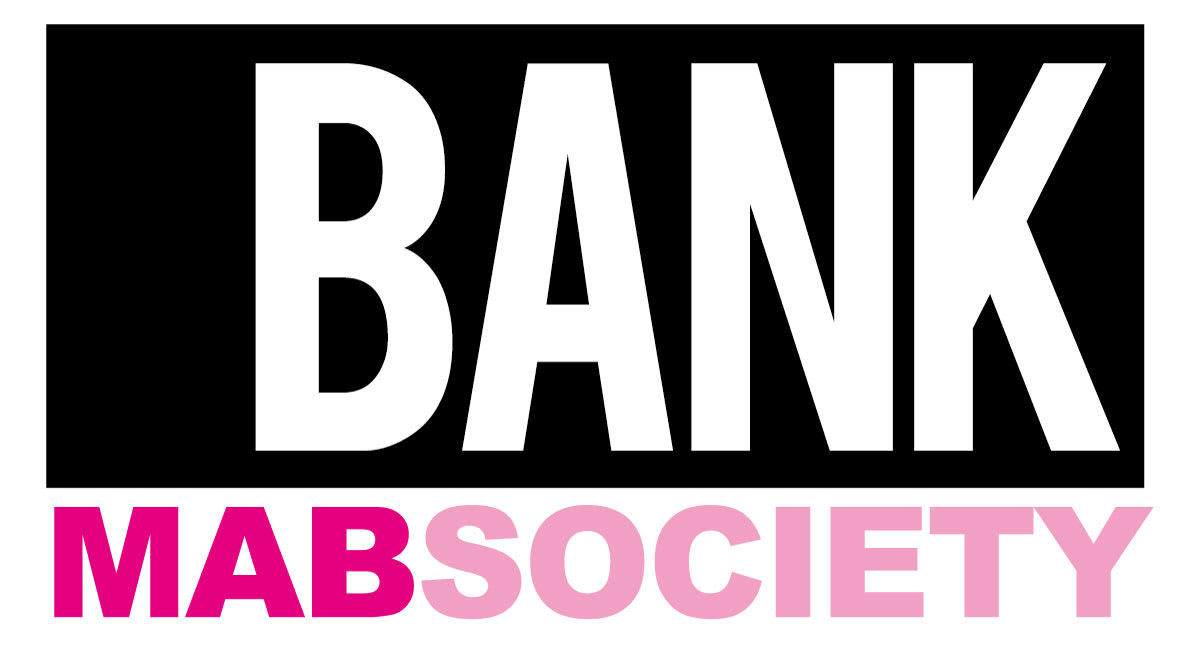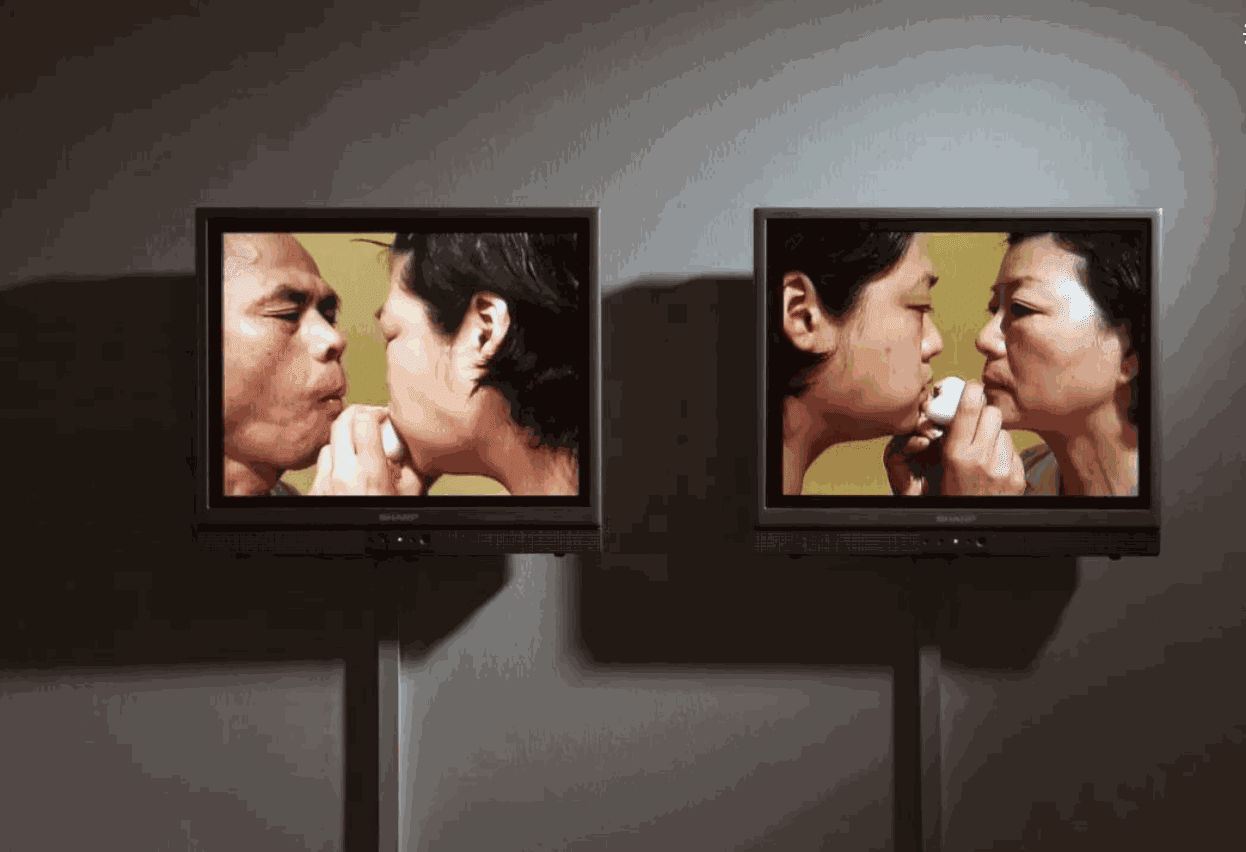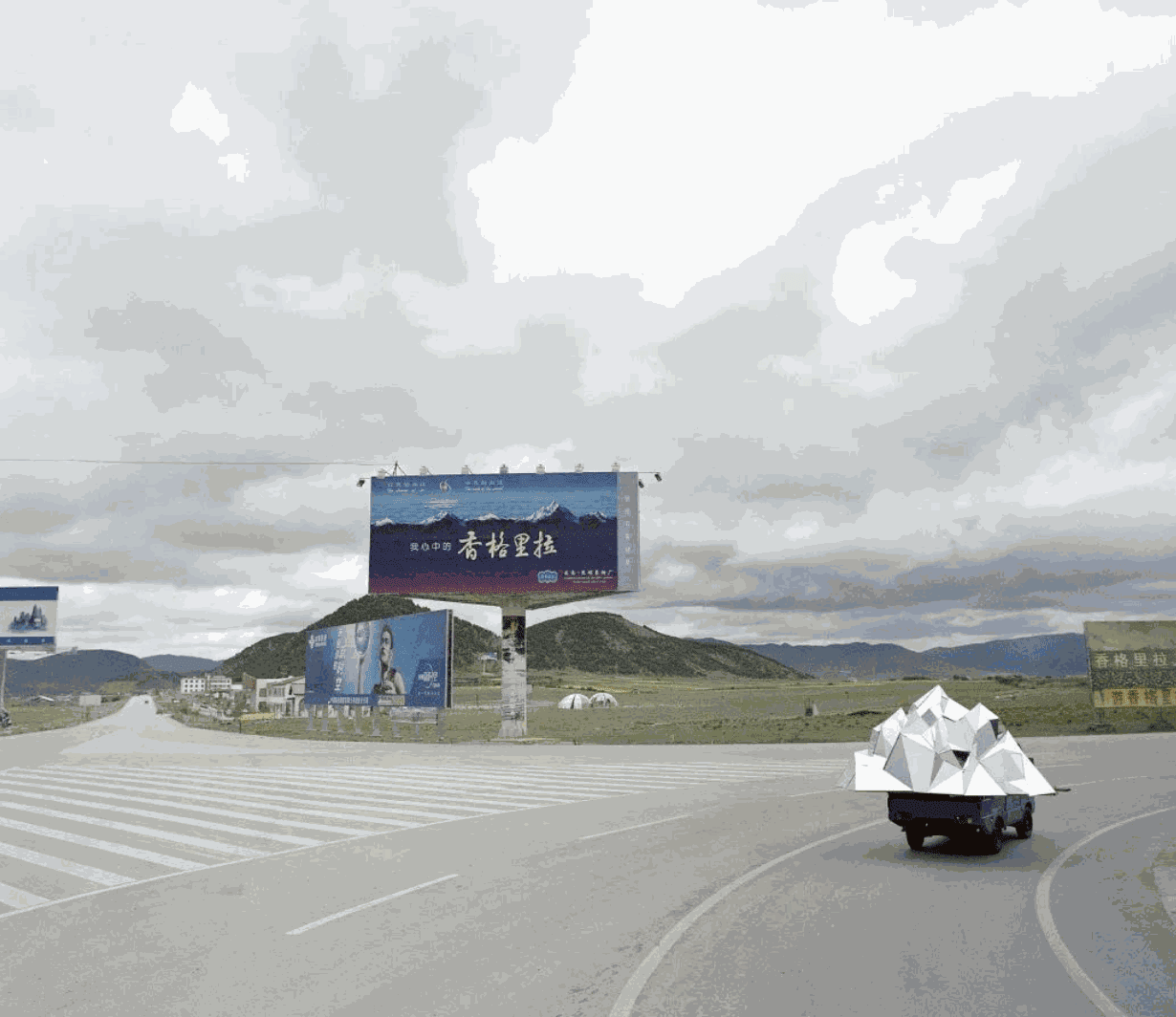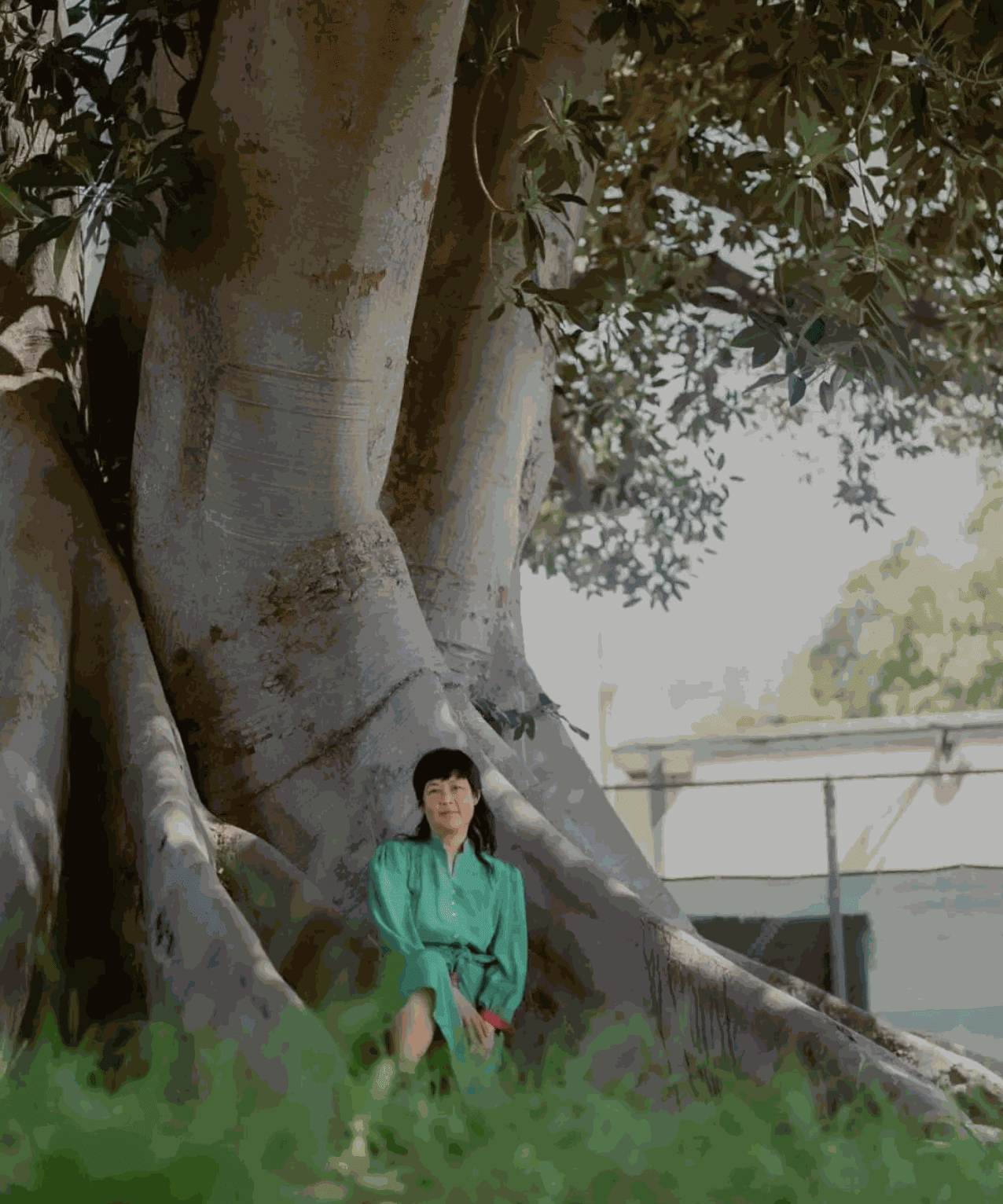In March 2020, when schools were closed, the artist Patty Chang decided she needed a pool on land. "It was the first thing I thought of," Chang recalled. At the time, her son Leroy was 8 years old, living with four other children in a pod. She thought a swimming pool would provide a perfect container and a designated activity space for these children who had just left home. They ordered one online and set it up in the backyard, where the kids swam all summer.
Two years later, when the urgent need for the pool had faded and the slightly chlorinated water had become overrun with black algae, it found a new purpose. It became the backdrop for the final scene of Chang's video work We Are All Mothers (2022), which is currently on view at the ICA Los Angeles as part of the exhibition Scratching at the Moon, a deeply intimate show focusing on Asian American artists working in Los Angeles.
While creating the video, Chang asked her son if he would be willing to swim with her. He agreed, and on a cold night, they donned wetsuits and filmed underwater with GoPro cameras. The final footage feels strangely familiar, engaging, yet ethereal—sometimes you can clearly see a body swimming, other times you only catch glimpses of hair, or the distorted patterns of their colorful wetsuits blurred by the water. As the footage plays on screen, Chang’s voice is clear and steady, listing the crises unique to the experience of giving birth and raising children: "The crisis of not being able to work, the crisis of not having your body and mind belong to yourself."
We Are All Mothers encompasses themes that Patty Chang has been exploring for years: the relationship between the external world and her own body (including water and bodily fluids), as well as the powerful yet elusive concept of "care." For Chang, "care" is not only about traditional forms of caregiving but also about the caregiving environment. It is also intertwined with fear. The anxieties brought on by parenthood and the intensifying climate crisis have become central to her recent projects. These projects take on added significance in the context of the pandemic, which pushed caregivers to the brink, and during the election year when Trump promised to roll back environmental protections. The subtlety in her work lies in its clear invocation of collective fear, which no longer feels like an obstacle but rather like an opening to a more public and porous world.
In April of this year, I visited Patty Chang in her studio (which also serves as her living room), where she has been working for many years in a garage. Two years ago, she and her husband and longtime collaborator, David Kelley, began building a two-story studio to replace the garage. However, construction stalled due to an incorrect electrical line running through their backyard, and they had to wait for the necessary municipal permits. During this period, she learned how to stay focused amidst the distractions of family life.
Currently, her studio floor is scattered with sculptures in progress: painted ceramic plates and tools that resemble devices used to measure water turbidity. On the table are research materials, including images of polymetallic nodules discovered on the ocean floor. These are materials for a project she is working on with David Kelley, which will be presented at the San Jose Museum of Art this fall. The project, titled Stray Dog Hydrophobia, uses the United Nations' 2023 decision to allow deep-sea mining in areas beyond national jurisdiction as a starting point. It continues Chang’s ongoing interest in the relationship between the ocean and the human body. In March of this year, she and Kelley traveled to Kingston, Jamaica, to attend the 29th session of the United Nations International Seabed Authority, uncertain of what useful material they would find. In the end, they traveled by boat with marine biologists to the "sunken pirate city," a place that sank into the sea after an earthquake in 1692. Archaeologists are still able to glimpse 17th-century life here, offering a profound example of the entanglement between humans and the ocean.
“For all of my work, I think the entire process of making it changes everything I know, and everything I think about,” Patty Chang said. “Otherwise, why would I make it? After all, no one asks you to do it.”
Chang was born in 1972 in San Leandro, just south of Oakland, California. Her parents were Chinese immigrants. Her father pursued his Ph.D. at the University of California, Berkeley, and later worked in the computer field, after which they settled in the East Bay. Chang grew up there, spending her entire childhood drawing. “I didn’t have any other skills,” she said, which also explains why studying art seemed like the obvious choice. She attended the University of California, San Diego, because it offered her the most financial aid, and the school’s location was just far enough to distance her from home. Since the late 1960s, UCSD had been a hotbed for conceptual and performance artists. Later, when Chang realized who her professor was, she “was very shocked.” Artist Eleanor Antin, a witty and humorous feminist polymath, encouraged Chang to take performance classes in her senior year. By the time she graduated in 1994, Chang had firmly established herself as a performance artist.
Patty Chang moved to New York, where she quickly emerged in the alternative scene stirred up by the culture wars. The performance pieces she designed were like refined, clever jokes. She worked in her apartment, using props bought from thrift stores and supermarkets to hone her ideas, which often came quickly. Chang recalled, "I could do anything, anywhere, whenever I wanted." While shooting Alter Ergo (1997), she wore a gray skirt and a white shirt buttoned all the way up, using dental clips to open her mouth, which was stuffed with mint candies. She stood like this until saliva dripped down her chin in a pink stream, eventually staining her suit. In 1997, Chang performed this piece for the first time at the new performance series at the nonprofit organization Exit Art in SoHo, prompting critic Margaret Sundell to describe Chang’s "signature brand" as a fusion of "60s-style body art and 90s riot grrrl feminism." In her three-minute performance video Melon (1998), she wore a bulky white bustier with two melons stuffed in the front. Balancing a plate on her head, she sawed open the left side of the bustier with a serrated knife, revealing the melon’s flesh. Then, she scooped the pink fruit out of the area that resembled breasts with a spoon and ate it.
Artist Anna Sew Hoy told me, "Patty's early videos and performances were so intense, bold, and shocking. When they happened, the dramatic impact was immediate." Sew Hoy, who is the curator of the current ICA exhibition, recalled first meeting Chang at a backyard mud-wrestling event in New York in the late 1990s. Their friendship deepened in the early 2000s, as they both participated in significant exhibitions of Asian American artists at the time, including One Way or Another: Asian American Art Now, co-organized by the late Los Angeles curator Karin Higa. The exhibition highlighted how Asian American artists were thinking about and making art in new, diverse, and provocative ways.
Works on display include Zhang Yi's In Love (2001), a two-channel video in which Zhang appears to be French kissing her parents. In fact, Zhang Yi asked her parents to eat Onions with her because she knew the gesture was too affectionate, culturally unsought-after and uncomfortable to watch. Ms. Zhang's parents rarely discussed her work with her, but they agreed to participate, an expansive act that, like Ms. Zhang's later work, gently conveys intimacy as a way to explore the broader question of how we can care for one another in an often hostile world. Using your body in a performance can cause harm. Beginning in 1998, the market demand for behavior and video expansion caused Zhang Yi pressure, "I think I have a sense of losing autonomy."
In 2004, Patty Chang received a $50,000 commission from the Hammer Museum, which provided the support she needed to free herself from performances involving her own body and to rethink her approach to making work. It was during this time that she began collaborating with David Kelley on films exploring how human intervention alters landscapes and the lives of surrounding inhabitants. One such film, Shangri-la (2005), examined the inevitable outcome of the fictional Tibetan paradise town of Shangri-la in the real world. "Shangri-la" was a concept created by British novelist James Hilton in 1933. Flotsam Jetsam (2007) focused on the Three Gorges Dam on the Yangtze River in China, the construction of which recently forced over a million people to relocate.
"I could smell everything, I felt like I was always going to vomit," Chang recalled. "The barrier between me and the outside world became very thin, so I tried to think about this project through that experience." When her bodily experience re-entered her work, it deepened her interest in the relationship between humans and the natural environment.
Two years later, in 2014, when Chang weaned her son and mourned the death of her father from a neurological disease, she returned to Uzbekistan and traveled along the shores of the Aral Sea. She decided to express her experience by pumping breast milk along the way, usually during meal times. Since her son no longer needed breast milk, she poured it into cups or disposable food containers on the dining table. Because the local authoritarian government forbade her from filming outdoor architecture, these photographs of breast milk became the record of her journey. In an article she later wrote about the experience, she described the act of pumping and discarding as a "sympathetic loss of flow," where her dwindling breast milk supply seemed like the disappearing sea. Even without any physical discomfort, pumping was inconvenient, and this act, along with the photos it produced, perhaps more than broader environmental images, reflected Chang's care for the landscape and her commitment to spending time with it.
In 2017, Patty Chang’s The Wandering Lake was exhibited at the ICA Los Angeles. That same year, she moved to Los Angeles. Both she and David Kelley found jobs at the University of Southern California, and the summer after they moved into their Altadena home was the hottest summer in California's history, with temperatures soaring above 110°F (around 43.3°C). Chang said, “After moving to Los Angeles, my anxiety about the environment started to intensify, and it had already begun after I gave birth. I felt like I needed to actively do something about it.”
"Death"
"The death of Leroy"
"Death of humankind"
"113-degree temperatures every day"
"Water depletion"
These were some of the items on Chang’s first "Fear List" in 2018, which included 24 points in total. Chang sought comfort, and in the cool, air-conditioned environment of the Huntington Library, she wrote down the contents of this list on the thin research paper provided by the library. She had always enjoyed working in libraries. During the summer when the Woolsey fire burned nearly 100,000 acres of land, the perfectly controlled climate of the Huntington Library (always kept at 68°F) felt like a remedy for the drought-stricken city of Los Angeles. She said, "It’s like a resort here, a temperature perfect for self-protection."
Shortly after making the list, Chang met performer Kestrel Leah, who had just given birth. Although Chang’s son had grown up, she still linked many of her anxieties to her own early experiences of parenthood. She shared the “Fear List,” which she had originally written for personal reasons, with Leah. They decided that Leah would pump breast milk while reciting the list of fears, which included Chang’s fears as well as other fears casually collected from friends, and Chang would film it. However, when Leah began pumping, she couldn’t remember the lines she had to recite. The physical act of pumping distracted her. This became the seed for Milk Debt: a milker reciting fears from a teleprompter.
The Milk Debt exhibition, originally scheduled for May 2020 at 18th Street, was postponed due to the pandemic lockdown. Chang took this opportunity to collect more fears and film more performers, this time on Zoom—mothers pumping after long days, set against the rich backdrop of their family environments. The exhibition finally opened in September 2020, resonating with the moment’s pandemic realities and directly reflecting them. Jennifer S. Li wrote in Art Asia Pacific: "If one artwork could sum up the cultural mindset of global citizens during 2020, amid the ravages of the pandemic and political anxieties, Patty Chang's Milk Debt is that one work."
Like most viewers, I first saw Milk Debt online, and immediately grasped how, while universally acknowledging anxiety, the shared work of milking also served as an expression of collectivism in the face of an unstable world. Later, when I revisited the piece after the birth of my twins—after experiencing the metaphorical and literal pressure of breast pumps—I became even more fascinated by how this tense, mundane bodily experience coexists with many trivial and sublime fears. Much like the experience of first-time parenthood, Milk Debt dissolves hierarchies, where even small things, like the stress of grocery shopping, are worthy of care.
Before following Chang and her son underwater, Chang’s video We Are All Mothers at the ICA stays with a completely different image. We see a pair of gloved hands gently caressing a dead river dolphin, then examining its body, the smooth gray skin placed on a cold metal table. These shots come from Chang’s collaboration with historian Astrida Neimanis and her sister, wildlife pathologist Aleksija Neimanis.
Throughout 2021, the three of them met regularly on Zoom. Astrida and Patty lived on the West Coast, and they would wake up in the middle of the night to watch as Aleksija, in Sweden, performed the necropsy of a dead river dolphin. One night, while watching in her garage, Aleksija discovered breast milk inside the belly of a young dolphin, prompting Patty to wake up the next morning and write the story of the dolphin mother. She revisited her own fear of her child's death. In the video, Patty imagines the fatal injuries her son could sustain from an earthquake or car accident. She asks, "What would I do for him when he’s dying? What comforting words would I say to him?" After months of online meetings, the three collaborators finally met in person in September 2022 in Seattle, where they walked along the coast to the site where a humpback whale had died in 2016, reflecting on how that whale might teach people to care for one another.
When Anna Sew Hoy organized the exhibition Scratching at the Moon at the ICA, she felt it was very fitting to include We Are All Mothers. We Are All Mothers is not only Patty’s most recent work but also reflects Sew Hoy’s admiration for her close friend. "Patty does not look away from environmental destruction," Sew Hoy said. "She places herself in the middle of it—that's her bravery." For herself, Patty doesn’t feel particularly brave; she just feels she has to face her fears. "I’ve been thinking about how reflections on disaster can give rise to new thoughts, and how not to shelve them away," Patty said. When I asked if the anxiety that prompted her to create Milk Debt had subsided, she responded, "Maybe making art helps."
At the end of the video essay, when the underwater shots fill the screen, Patty Chang reflects again on her own death. What would happen if she passed away before her son grew up and was ready to take care of himself? She comforts herself, saying, "Maybe many animals live this way. It’s not a tragedy." This is one of Patty’s strengths: turning pragmatic observations into poetry. Here, by embracing the extremes of nature, she makes one feel strangely expansive about the inevitability of death, just as death connects us with other species and ecosystems. Clearly, it does.












